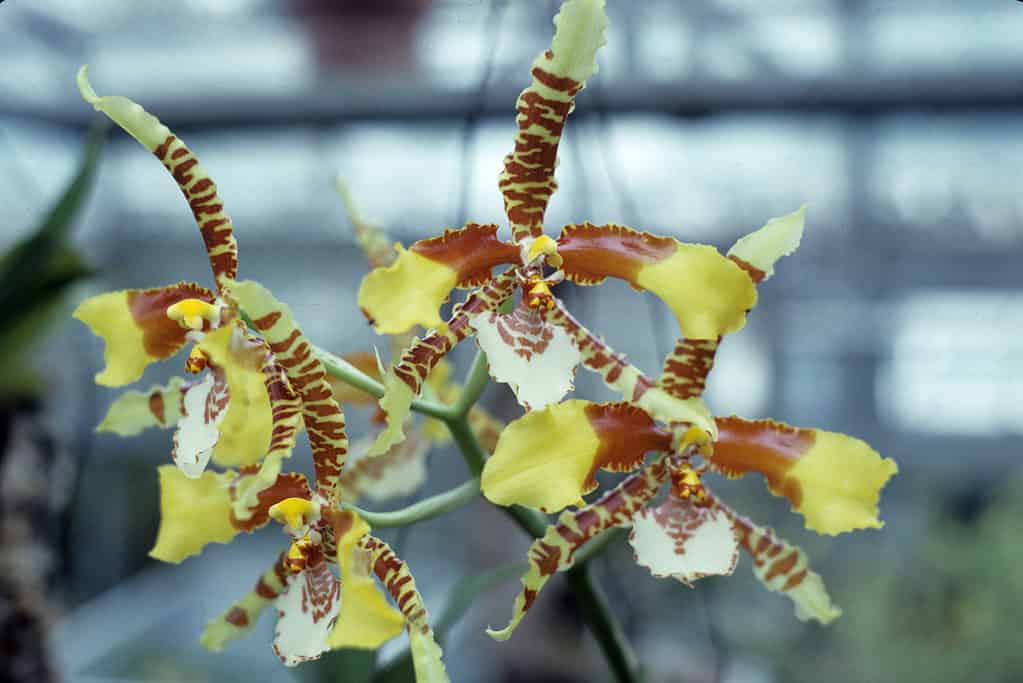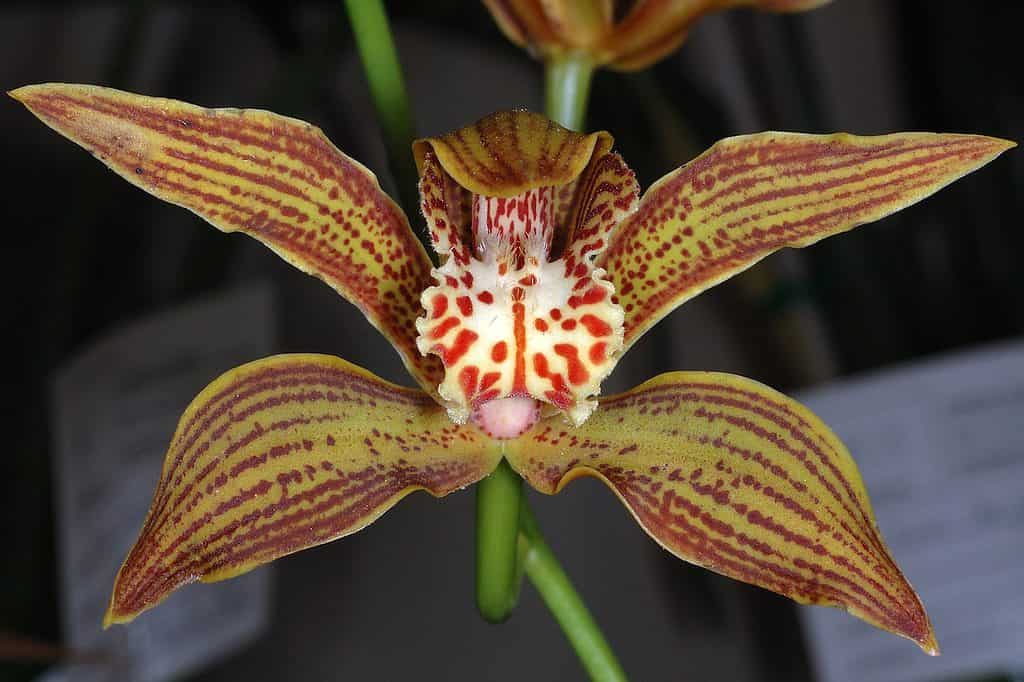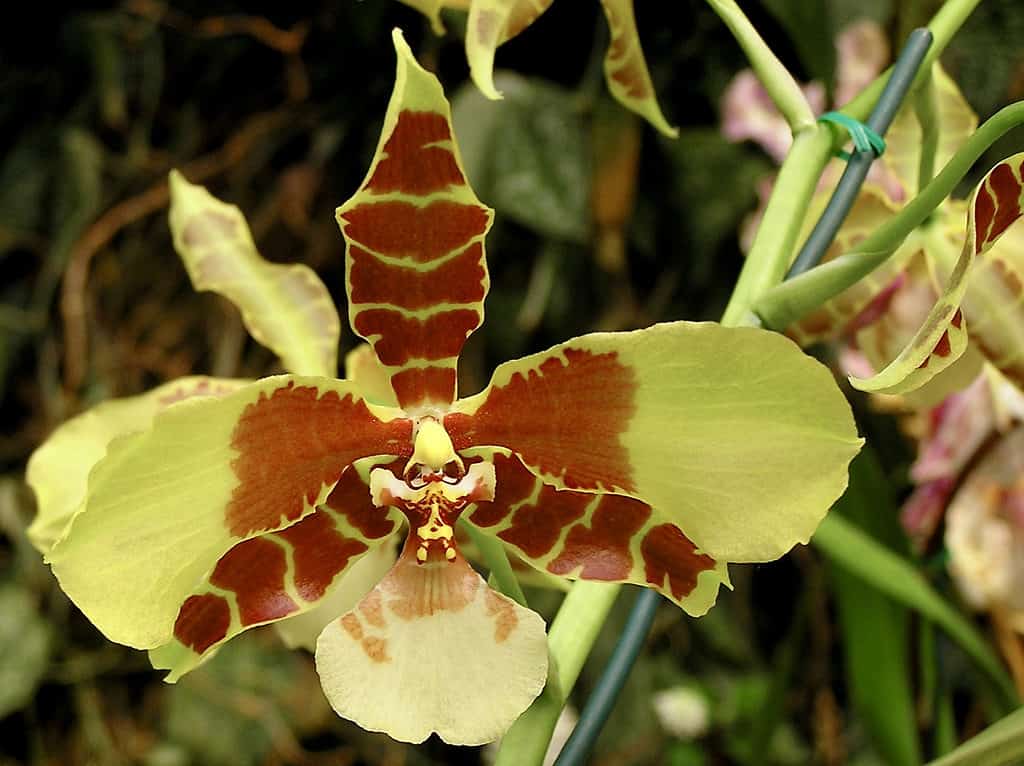While many orchids produce bright, vividly colored blooms, some create subtler, more earth-toned pigments that are nonetheless beautiful. If you want to add a serene, grounded feel to your orchid collection, consider adding brown-flowered orchids.
In this guide, we’ll touch on the botanical classification and general overview of the orchid family. We will then cover three brown orchid species, their native ranges, and morphologies and provide guidelines for care requirements.
So, without further ado, let’s jump in!
Orchids: Botanical Classification
The Orchidaceae family contains almost 30,000 species of highly diverse, intricate, and stunningly beautiful flowering plants. Orchids are masters of mimicry and produce vibrant colors, stunning variegation, and enticing fragrances. They have evolved to grow natively on every continent except Antarctica. A huge market exists for naturally occurring orchid species and varieties, cultivars, and hybrids.
While new cultivars pop up regularly on the market, these plants existed long before Homo sapiens emerged on this planet. 112 million years ago, terrestrial orchids appeared on the flowering plant scene. Once a branch evolved as epiphytes (growing non-parasitically on other plants such as trees), their diversity exploded. Now, the Orchidaceae family represents 10% of all flowering plant species on the planet. Orchids are terrestrial, epiphytic, and lithophytic (grow on rocks). They are distributed across a range of climates around the world.
This diverse botanical family includes tropical, heat-loving epiphytes that thrive in the Amazon Basin, cool-weather, mountainous lithophytic species that cling to limestone outcrops of Northern China, and hardy terrestrial species that thrive in woodland forests across North America.

While many orchids produce bright, vividly colored blooms, some create subtler, more earth-toned pigments that are nonetheless beautiful.
©Wayne Ray, Public domain, via Wikimedia Commons – Original / License
Three Beautiful Brown Orchid Species
If you prefer a shade garden or houseplant space with more subtle flower tones and an earthy, foresty feel, then brown orchids might be right up your alley! They can provide intricate flower shapes and petal mottling typical of orchids while not overwhelming a space with bright colors. They can also balance a colorful display of red-flowered orchids, for example. Or brown-flowered orchids could add a gentle contrast among brighter flowers in a bouquet.
To get you started on your journey, in this guide, we’ve chosen three orchid species that hail from a range of native environments and produce beautiful brown blooms. We’ll discuss the following three species:
- The Iris-Like Cymbidium (Cymbidium iridioides)
- Tiger’s Mouth Orchid (Rossioglossum grande)
- Mountain Lady’s Slipper Orchid (Cypripedium montanum)
Read on to learn all about these lovely orchids and what they need to thrive.
1. The Iris-Like Cymbidium (Cymbidium iridioides)
Native to regions of the Himalayas, Myanmar, Vietnam, and India, this cool-to-cold growing epiphytic (attaches non-parasitically to plant, usually trees) or lithophytic (growing on rocks) brown orchid can be found at elevations between roughly 3,000 to 9,000 feet. Commonly named for its similar appearance to an iris, Cymbidium iridioides is one of about 100 orchid species in the Cymbidium genus.

is commonly named The Iris-Like
Cymbidiumfor its similar appearance to an iris.
©Eric in SF, CC BY-SA 3.0 <https://creativecommons.org/licenses/by-sa/3.0>, via Wikimedia Commons – Original / License
Morphology
The iris-like Cymbidium is quite a lovely orchid, especially for gardeners who love earth tones. The elongated, narrow sepals and lateral petals feature a brownish-yellow background with dense brown striping. The labellum (modified lower petal, or lip) hangs down like a ruffled ascot. It typically produces a white background with yellow shading at the bottom and reddish-brown mottling.
The blooms are 3-4 inches wide, emerge in the summer, and fall in clusters of 4-20 along an arching, green, fleshy stem 18-36 inches long. The leaves are mid-green, numerous, and grass-like and grow in a steeply arching pattern up to 36 inches long.
Plant Care
If you live in a cool region, you should have little trouble growing these fairly low-maintenance orchids. Just remember that these aren’t terrestrial orchids and can’t be grown in a soil-based medium. Below, we’ll provide the specific care requirements for these earthy, beautiful brown orchids.
Watering
During their growing period in the spring and summer, Cymbidium iridioides require frequent watering. It’s best to avoid letting the roots or growing medium dry out, especially if the plant is mounted on bark. During the winter, however, you can cut back on watering as this plant produces substantial pseudobulbs that can store nutrients and water during dormancy. As such, you can allow the growing medium to just dry out before watering again in the winter.
Light
Cymbidiums that grow in higher elevations, like the iris-like orchid, typically have higher light requirements. This orchid should be happy with a maximum of 50% shade and direct sunlight in the morning. Avoid mid-day direct sun exposure. Once blooming begins, you can eliminate direct sunlight to maintain the color vibrancy.
Temperature and Humidity
Temperature requirements for cymbidiums tend to be broken down into three categories:
- Orchids with standard-sized blooms from China and the Himalayas require a period of cool nights in the late summer and early fall to initiate blooming.
- Orchids with small-sized blooms from China and the Himalayas don’t require a notable chilling period to bloom and do well in cool to warm temperatures year-round.
- Orchids with small-sized blooms native to tropical climates that require no chilling period and thrive in year-round warm to hot temperatures.
The iris-like orchid falls in the first category. As such, you want to expose your orchid to a cool period around early fall in which nighttime temperatures do not exceed about 53 degrees Fahrenheit. During the summer, temperatures should not exceed about 80 degrees Fahrenheit.
This orchid prefers moderate humidity year-round, so aim for 40-60% humidity levels. As with all orchids, ensuring consistent airflow is crucial for a healthy plant.

The iris-like
Cymbidiumhas elongated, narrow sepals and lateral petals, which feature a brownish-yellow background with dense brown striping.
©Michael Wolf, CC BY-SA 3.0 <https://creativecommons.org/licenses/by-sa/3.0>, via Wikimedia Commons – Original / License
Growing Medium and Fertilizer
This mostly epiphytic orchid does best either mounted to bark or growing in an open-slotted wooden basket. If growing in a basket, a water-retaining but still well-draining mix like a medium-sized chopped fir bark with chopped peat moss and perlite is a popular choice.
Cymbidiums require pretty heavy fertilizing to thrive and produce gorgeous blooms. In the early period of its growing season, use a high-in-nitrogen, water-soluble orchid fertilizer to encourage excellent foliage development. By late summer, switch to a high-in-phosphorus orchid fertilizer to encourage blooming. While it’s actively growing, fertilize at full strength with water every week to two weeks. Cut back drastically to fertilizing once per month in the winter.
2. Tiger’s Mouth Orchid (Rossioglossum grande)
An epiphytic, cool-to-warm growing brown orchid, the tiger‘s mouth orchid (Rossioglossum grande) can be found growing natively in southern Mexico, Guatemala, and Belize at elevations between about 4,600 to 8,900 feet. It is one of 11 species currently recognized in the tiny Rossioglossum genus. You may also find the tiger’s mouth orchid referred to botanically as its previous scientific name, Odontoglossum grande.
Morphology
Like many species in the Rossioglossum genus, the tiger’s mouth orchid produces blooms that appear wide-stance with elongated, narrow, wavy sepals stretching out and away from each other with much broader lateral petals. The sepals are yellow with red-brown striping, and the lateral petals feature a two-toned appearance with yellow shading on the outer half of the petals and red-brown on the inner half. The labellum is enlarged and shaped like a wavy disc. It’s mostly white with light brown striping near the inner portion and along the wavy margin. The column is mostly yellow and red-brown.
The blooms are typically 4-6 inches wide and emerge in the late fall in groups of 2-3 flowers per bare, branching stem. Stems are normally 12 inches long, arching to upright, and can range from 2-8 per plant. The numerous leaves are mid-green, broad, semi-glossy, and ovate-to-elliptical with smooth, entire edges. Blooms are long-lasting for up to two months.
Plant Care
A lovely addition to add to your collection, especially for a jungle-y feel, the tiger’s mouth orchid is relatively easy to care for in subtropical regions. We’ll cover below a detailed guide on helping this plant thrive.
Watering
This orchid prefers consistent moisture, especially in its growing period. During this time, avoid allowing the growing medium to dry out without waterlogging the roots. This epiphytic orchid does not tolerate mineral buildup well, so avoid using water sources with high mineral contents. The tiger’s mouth orchid does require a winter rest period with drier conditions, so allow the medium to just barely dry out between watering during this time.
Light
Bright, indirect light is perfect for this lovely orchid. You can also provide direct sun in the morning but avoid direct sun exposure at other times of the day.
Temperature and Humidity
The tiger’s mouth orchid doesn’t experience a significant difference in the temperature range between summer and winter, and it generally appreciates mild temperatures. So, during the summer, aim for a maximum high of 80 degrees Fahrenheit during the daytime and a maximum of 60 degrees at night. In winter, temperatures shouldn’t dip below 50 degrees Fahrenheit. Still, you should make sure this plant is exposed to cooler temperatures during its winter rest period in order for growth to initiate in the spring.
An ideal humidity range is 50-70%, with the lower end of the range being ideal during the winter. As always, ensure consistent air movement for healthy roots.
Growing Medium and Fertilizer
For this species, you have a range of growing mediums to choose from, so long as they promote rapid draining and aeration. Potting this plant in open-slotted wooden containers is an excellent option. The potting medium choices include perlite, charcoal, coarsely chopped peat, lava rock, bark, and perlite. Like other species in the Rossioglossums genus, the tiger’s mouth orchid thrives on a balanced, water-soluble orchid fertilizer that contains micronutrients. Aim for fertilizing weakly weekly during its growing phase with 1/4th the dosage. Cut back to once-per-month feedings during the winter.

The brown orchid
Rossioglossum grandedisplays colors of yellow with red-brown striping.
©NasserHalaweh, CC BY-SA 4.0 <https://creativecommons.org/licenses/by-sa/4.0>, via Wikimedia Commons – Original / License
3. The Mountain Lady’s Slipper Orchid (Cypripedium montanum)
Native to the West Coast of North America from British Columbia to California, spanning east to Alberta, Montana, and Wyoming, the mountain lady’s slipper is a sweet-scented, terrestrial, temperate orchid. It belongs to the group of orchids commonly named lady’s slipper orchids, called such for their slipper-like labellum. This particular species, Cypripedium montanum, grows in moderately moist to arid coniferous and mixed hardwood forests, and in open and semi-open areas such as on slopes, in thickets, and in meadows. The mountain lady’s slipper is one of 45 species of terrestrial orchids in the Cypripedium genus.
Morphology
As is typical with lady’s slipper orchids, Cypripedium montanum features a flower with a notably large labellum that resembles a cartoonish slipper and functions like a pouch. This slipper-like labellum temporarily traps pollinators, who must climb out of the pouch in a manner that covers them in pollen. In the case of the mountain lady’s slipper, the labellum is stark white with deep red-purple interior venation.
This orchid’s elongated, narrow sepals and lateral petals are a lovely purple-brown with some yellow highlighting towards the interior. The lateral petals are notably elongated and twist in spirals.
The up to five leaves emerge in an alternating pattern, lack a petiole, are broad, elliptic, and grow between 2-6 inches long. Flowers typically bloom in a singular fashion or up to three per 8-20 inch long stem in late spring through mid-summer.
Plant Care
The transplant success rate for these orchids is extremely low, so avoid digging up wild specimens and stick to sourcing them from ethical wildflower nurseries. Below, we’ll discuss the details of keeping your mountain lady’s slipper orchid happy and healthy.
Watering
Like many terrestrial orchids, the mountain lady’s slipper orchid requires a balance between evenly moist but not soggy soil. You’ll want to keep this plant well-watered, especially in its spring and summer growing phase. When you notice the growing medium starting to dry out, it’s time to water again. During dormancy, reduce watering to allow the soil just to become dried out before watering again.
Light
This orchid can handle a fairly wide range of light intensity from medium, indirect sunlight to full sun exposure in the morning hours. This reflects its native range of environments, from woodlands to more open meadows. It’s important to remember that when this plant receives direct sunlight in a meadow, it is protected by all of the taller grasses and other flowering plants.
An ideal treatment for the mountain lady’s slipper orchid is full sun in the morning, followed by bright, indirect sunlight for the remainder of the day.

The mountain lady’s slipper orchid features a flower with a notably large labellum that resembles a cartoonish slipper and functions like a pouch.
©iStock.com/Chris Babcock
Temperature and Humidity
These plants grow natively in Alaska, so they’re reliably cold-hardy and require exposure to temperatures below 40 degrees Fahrenheit for three months to trigger spring growth. Remember, in nature; the roots are usually insulated to an extent from fallen leaves, so adding an inch of chopped leaves after the plant enters dormancy helps protect the plant. In the summer, ideally, keep temperatures below 80 degrees Fahrenheit.
Moderate humidity around 50% year-round is ideal for this terrestrial orchid.
Growing Medium and Fertilizer
The ideal soil for Cypripedium montanum is fertile, well-draining, and well-aerated with moderate moisture retention. Planting in clay pots can help wick excess moisture from the soil, and adding perlite and sphagnum moss to your potting mix can improve drainage while preventing the soil from drying out too quickly.
Fertilizing for this species is most important when new growth appears in the spring. For best results, feed with a balanced. water-soluble orchid fertilizer at 1/2 strength every 10 days. Some growers find success by alternating every other feeding with a seaweed-based fertilizer. You can stop fertilizing altogether during dormancy.
The photo featured at the top of this post is © Rosalee de la Forêt, CC BY-SA 3.0
Thank you for reading! Have some feedback for us? Contact the AZ Animals editorial team.







